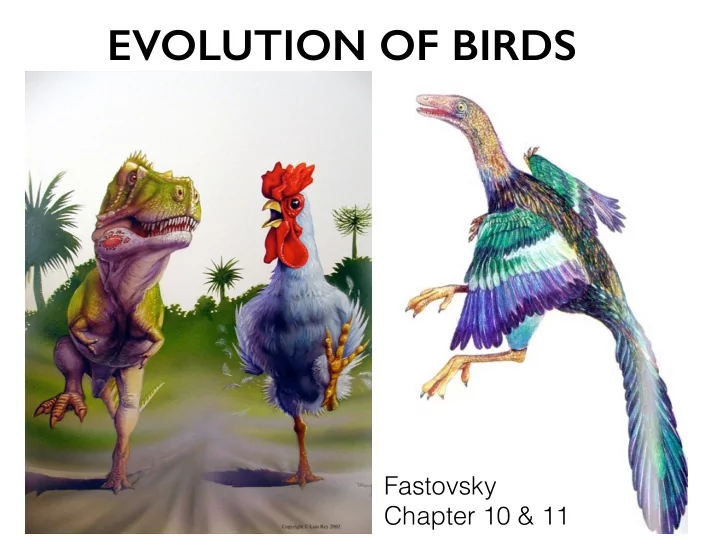

EVOLUTION OF BIRDS Fastovsky Chapter 10 & 11
Is it a Dinosaur or Bird? DINOSAUR! Jinfengopteryx
DINOSAUR! Is it a Dinosaur or Bird? Microraptor
Is it a Dinosaur or Bird? BIRD! Jeholornis
Is it a Dinosaur or Bird? DINOSAUR! Mahakala
BIRD! Is it a Dinosaur or Bird? Archaeopteryx
Is it a Dinosaur or Bird? DINOSAUR! Rahonavis
Is it a Dinosaur or Bird? DINOSAUR! Anchiornis
Dinosaur Color Patterns This is the actual coloration of the Jurassic dinosaur Anchiornis Distribution of two types of preserved pigment cells (melanosomes) allows actual color pattern to be determined
First, what is a bird? Alula Feathers Loss of teeth Large brains, adv. sight Carpometacarpus Uncinate Process Bipedal Pygostyle Pneumatic bones Rigid skeleton Furcula (wish bone) Sternal Ribs 10
Feathers d) b) c) a) a) Central shaft b) Barbs radiate from shaft c) Barbs can be linked by Barbules d) A sheath of linked barbs = Vane 11
12 Parrot Feather
Birds: Powered flight Trioseal Foramen Wing Downward stroke: Pectoralis Recovery stroke Supracoracoides Attached to to the keel; similar to Pectoralis... but how does it cause opposite motion? Hooked via tendon through the TRIOSEAL FORAMEN... unique in Animal Kingdom 13
Quick Review! Oviraptor Therazinosaurs Avialae Tyrannosaurs Ceratosaurs Spinosaurs Troodontids Dromaeosaurids Carnosaurs Ornithomimosaurs Derived Maniraptors Intermediate Coelurosauria Basal (Tyrannosauria onwards) Theropods: Simplified
Now we know what birds are... But which traits are unique? Feathers Loss of teeth Loss of teeth Large brains, adv. sight All Theropods Carpometacarpus Coelurosauria Carpometacarpus Bipedal Derived Theropods Pygostyle Pygostyle Pneumatic bones Rigid skeleton Rigid skeleton Furcula 15
Bird Ancestors In the 1960s, paleontologist John Ostrom championed the idea that birds descended from theropod dinosaurs Deinonychus (Dromaeosauridae) 16
Bird Ancestors Evidence that theropod dinosaurs are the ancestors of birds comes from four major aspects of their biology 1. Oology (eggshell, nest, and egg-laying) 2. Behavior 3. Osteology (bone structure) 4. Integument (skin covering) 5. Molecular Evidence (Amino Acid sequences from T. rex) 17
a) Macrostructure b) Microstructure c) Ultrastructure Evolution of oval, and then asymmetrical eggs
Oology a) Macrostructure multi b) Microstructure multi (Study of eggs) c) Ultrastructure multi single multi multi multi multi multi Deinonychus eggshell Sauropods Theropods and birds Theropods share multi-layered eggshell structure 19 (prismatic and laminar)
Autochronous Ovideposition Crocodiles, sauropods, and ornithischians laid all eggs at once Theropods and birds laid two (or one) eggs at a time Asymmetrical eggs in advanced non-avian theropods may indicate single functional oviduct
Theropods actively brooded their egg clutch, like birds Crocodiles and sauropods have minimal parental care and buried eggs in pile of sand/leaves Oviraptorid Citipati
Behavior – Sleeping Position Troodontid Mei long
Furculum (“Wishbone”) Formed by fusion of clavicles, gradually changed from boomerang shape to wishbone shape In birds, acts as strut or spring to resist compressional forces during flight stroke Tyrannosaurus Turkey Archaeopteryx
Tyrannosaurus Fused Sternum Pectoral girdle fused into large sternum in later theropods and birds In birds, provides large attachment surface for flight muscles Deinonychus
Ventral Ribs Theropods and birds have bony sternal ribs and uncinate processes connecting ribs Uncinate process Sternal rib
Uncinate Processes In birds, prevent ribcage from being crushed during powerful flight stroke An integral part of theropod and bird respiratory system
Semilunate Carpal Half-moon shaped wrist bone first found in advanced theropods Important for wing folding during avian flight stroke
Integument – Feathers Animals with feather MUST be endothermic. Logic : If you require external heat, why would you insulate yourself? No ectothermic animals have insulation 28
Integument – Feathers Feathers first evolved in non-avian theropods Downy (plumulaceous) feathers in coelurosaurians like Sinosauropteryx and tyrannosaurs
Quick Review! Oviraptor Therazinosaurs Avialae Tyrannosaurs Ceratosaurs Spinosaurs Troodontids Dromaeosaurids Carnosaurs Ornithomimosaurs Derived Maniraptors Intermediate Coelurosauria Basal (Tyrannosauria onwards) Theropods: Simplified
Integument – Feathers Vaned (pennaceous) feathers in maniraptorans (oviraptorids, troodontids, dromaeosaurs) like Microraptor
Quick Review! Oviraptor Therazinosaurs Avialae Tyrannosaurs Ceratosaurs Spinosaurs Troodontids Dromaeosaurids Carnosaurs Ornithomimosaurs Derived Maniraptors Intermediate Coelurosauria Basal (Tyrannosauria onwards) Theropods: Simplified
Integument – Feathers Even larger theropods like Velociraptor had feathers Quill knobs on ulna (lower arm bone) indicate attachment sites for large vaned feathers
Molecular Evidence: Amino Acid Sequences Collagen : a protein coded by a sequence of amino acids Compare collagen amino acid sequences across many different lifeforms and group by similarity!
Dinosaurs... tastes like chicken...
Now let’s think about flight... Feathers Loss of teeth Loss of teeth All Theropods Large brains, adv. sight Coelurosauria Carpometacarpus Carpometacarpus Derived Theropods Bipedal Pygostyle Pygostyle Pneumatic bones Rigid skeleton Rigid skeleton Furcula 36
Did feathers and pneumatic bones evolve for flight? Obviously not... evolved long before flight Embryological Evidence Feather Development: There are 4 stages of feather development controlled by a series of genes. Each stage is a developmental modification of the last! Formation of shaft Formation of loosely connected, Hooked barbs on a Hooked barbs on an unhooked, barbs symmetrical vane asymmetrical vane
Did feathers and pneumatic bones evolve for flight? Obviously not... evolved long before flight Paleontological Evidence Covered in barbed filaments Sinosauropteryx : small Coelurosaur; was not capable of flight 38
Did feathers and pneumatic bones evolve for flight? Obviously not... evolved long before flight Paleontological Evidence Well developed barbs & barbules Symmetrical veins Caudipteryx: Oviraptorid
Did feathers and pneumatic bones evolve for flight? Obviously not... evolved long before flight Paleontological Evidence Covered in barbed filaments Beipiaosaurus Ostrich-sized Therizinosauroid
Did feathers and pneumatic bones evolve for flight? Obviously not... evolved long before flight Paleontological Evidence Bird-like Feathers Sinornithosaurus non-flying Deinonychosaur
Did feathers and pneumatic bones evolve for flight? Obviously not... evolved long before flight Paleontological Evidence Bird-like Feathers Microraptor flying Deinonychosaur
Recommend
More recommend